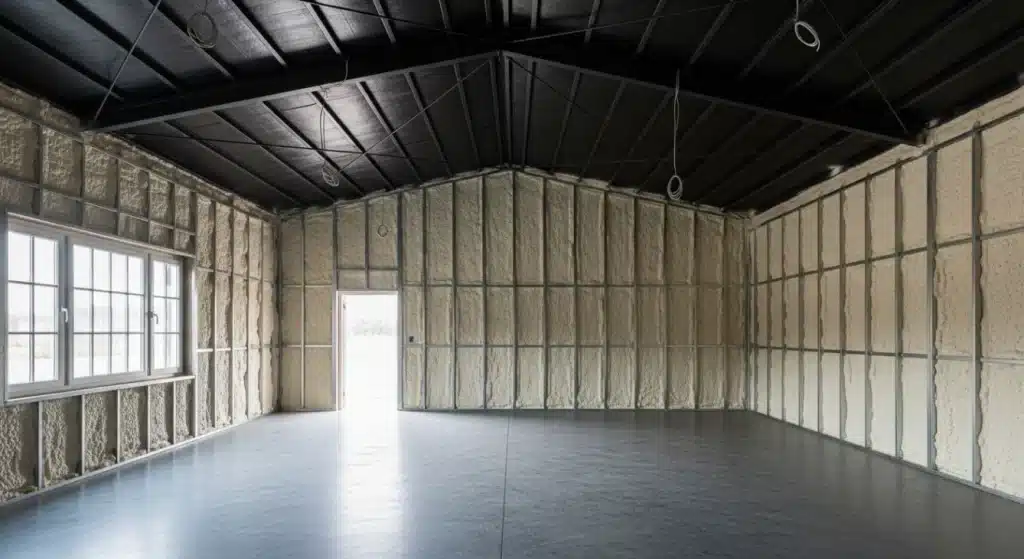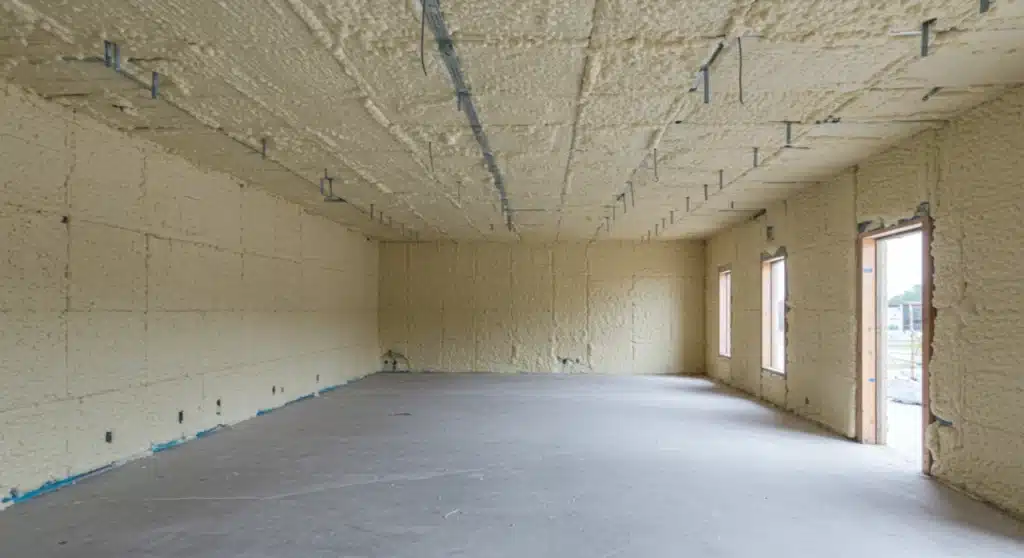Imagine stepping into a home where the air stays cool in summer and warm in winter without cranking up the heat or air conditioning. That comfort comes from good insulation, but many people overlook it until bills climb or drafts sneak in. Insulation acts as a barrier that slows heat flow, keeping indoor spaces efficient and cozy year-round. In places like Fresno, where hot summers and chilly nights alternate, effective insulation makes a real difference in daily life and long-term savings.
This guide breaks down everything you need to know about insulation, from the basics of what it is and how it works to the types of materials available. You’ll also find advice on choosing options for your home or building, budgeting effectively, installing properly, and evaluating results.
Drawn from years of working with insulation projects across various buildings, this resource aims to equip you with practical knowledge. By the end, you’ll feel ready to choose, install, and maintain insulation that fits your space and wallet perfectly. Whether you’re a homeowner planning a retrofit or a business owner upgrading facilities, these details will guide your decisions.
Understanding Insulation Basics
Insulation starts with simple physics. Heat moves from warmer areas to cooler ones through conduction, convection, or radiation. Materials rated by R-value resist this movement, with higher numbers meaning better performance. For example, in a typical Fresno home, an R-30 attic setup can cut heat loss by up to 25%, based on local climate data.
Building on these physics principles, insulation’s real-world advantages include greater energy efficiency. You might wonder why insulation matters beyond comfort. It directly impacts energy use. Poor insulation forces heating and cooling systems to work harder, driving up utility costs. A study from the U.S. Department of Energy points out that homes with adequate insulation save 15% on heating and cooling bills annually. Beyond savings, it reduces strain on power grids and lowers carbon emissions, aligning with broader environmental goals.
Comfort ties in too. Even temperatures mean fewer hot spots or chills, improving how you feel indoors. Noise reduction adds another layer; dense insulation absorbs sound, making quiet spaces in busy areas.
Key Benefits for Energy Efficiency and Comfort
Efficiency gains show up quickly. Take a standard three-bedroom house: adding wall insulation might drop energy use by 10-20%. Comfort extends to health, as stable humidity levels curb mold growth and allergens. In commercial settings, like offices, it keeps employees productive without constant adjustments.
Long-term, insulation protects structures. It prevents moisture buildup that leads to rot or cracks, extending the life of roofs and walls.
Expert Tip: Check your current setup by feeling for drafts around windows and doors. A simple incense stick test reveals air leaks where smoke wisps toward cracks.
Types of Insulation Materials
Several materials handle insulation duties, each with strengths based on space and needs. Start with fiberglass, made from fine glass fibers, which is common for its affordability and ease of use in batts or rolls, according to the U.S. Department of Energy. Pros include wide availability and resistance to mold when installed dry. Cons? It can irritate skin during handling and settles over time, losing some effectiveness.
Cellulose follows, a recycled paper product treated for fire resistance, with up to 85% recycled content per Green Building Council. Blown-in versions fill attics well, offering high R-value per inch. It settles less than fiberglass but absorbs moisture if not sealed properly.
Spray foam expands on application, sealing gaps tightly. Open-cell types provide flexibility and soundproofing, while closed-cell offers superior moisture resistance and strength. Both excel in irregular spaces but cost more upfront, potentially boosting efficiency by 50% in leaky homes, according to Energy Star.
Rigid foam boards suit basements and exteriors, providing a vapor barrier. Mineral wool, from rock or slag, handles fire better than others and repels pests.
To compare, here’s a table of popular options:
| Material | R-Value per Inch | Cost Range (per sq ft) | Best For | Drawbacks |
|---|---|---|---|---|
| Fiberglass | 2.9-3.8 | $0.30-$1.50 | Walls, attics | Itchiness, settling |
| Cellulose | 3.1-3.7 | $0.60-$2.00 | Attics, walls | Moisture absorption |
| Open-Cell Spray Foam | 3.5-4.0 | $0.50-$1.00 (installed) | Irregular spaces | Less structural strength |
| Closed-Cell Spray Foam | 6.0-7.0 | $1.00-$2.50 (installed) | Wet areas, exteriors | Higher cost |
| Rigid Foam | 3.8-5.0 | $0.25-$2.00 | Basements, foundations | Needs covering for fire |
Data pulled from industry averages; actual costs vary by region.
Pros and Cons of Each Type
Fiberglass works in most DIY projects but requires protective gear. Cellulose shines in eco-friendly builds. Spray foam seals better.
Choose based on your goals. For fire-prone areas, mineral wool leads with non-combustible properties.
Expert Tip: Match material to climate. In humid spots like Fresno basements, closed-cell foam prevents water issues better than fibrous types.
Choosing Insulation for Your Space
Every building has unique demands. Residential homes focus on living areas, while commercial structures prioritize large-scale efficiency. Start by assessing square footage and climate zone. Fresno falls in a mixed zone, needing balanced R-values for both heat and cold.
For homes, attics top the list. They account for 25-30% of heat loss, so aim for R-38 to R-60. Walls need R-13 to R-21, depending on framing. Floors over unheated spaces benefit from R-25 or more to avoid cold feet.
Apartments or condos suit blown-in materials to minimize disruption. Basements demand vapor barriers to fight dampness.
Commercial spaces differ. Warehouses use reflective insulation for vast roofs, cutting cooling costs. Offices might blend spray foam for HVAC efficiency.
Residential vs. Commercial Applications
Homes emphasize quick ROI through lower bills. A $1,200 attic job could save $300 yearly. Businesses see bigger gains; insulating a 10,000 sq ft facility might trim $10,000 in annual energy expenses, per Building Green.
Tailor to layout. Tight urban apartments favor flexible foams, while rural homes handle batts easily.
Expert Tip: Map your space first. Sketch rooms and note access points to plan material flow without waste.
Here’s a checklist table for space-specific needs:
| Space Type | Recommended R-Value | Ideal Materials | Considerations |
|---|---|---|---|
| Attic | R-38 to R-60 | Blown cellulose or fiberglass | Ventilation to prevent moisture |
| Exterior Walls | R-13 to R-21 | Batts or spray foam | Air sealing before install |
| Basement | R-10 to R-15 | Rigid foam or closed-cell | Waterproofing integration |
| Floors | R-25 to R-30 | Batts or foam boards | Access from below if possible |
| Cathedral Ceilings | R-30+ | Spray foam | Baffles for airflow |
Use this to prioritize high-impact areas first.
Budgeting for Insulation Projects
Costs range widely, but planning keeps them in check. Materials alone run $0.30 to $2.50 per square foot, with labor adding $0.50 to $2.00 more. A full-home retrofit might total $3,000 to $15,000, depending on size and type.
Market data shows the global insulation industry hit $70 billion in 2022, growing at 5% yearly due to energy regulations, according to Grand View Research. In the U.S., homeowners recoup 75-95% of costs through savings within 5-7 years.
Break it down: DIY fiberglass saves on labor but risks poor installation. Professional spray foam, at $1.50-$3.00 per sq ft installed, seals better for long-term gains.
Leveraging incentives is a key way to stretch your budget further. Federal tax credits cover up to 30% for energy-efficient upgrades, per IRS guidelines. Local rebates in California add more for high-R-value projects.
To budget effectively:
- Calculate total square footage.
- Add 10% for waste.
- Include permits if required.
- Compare quotes from 2-3 contractors.
Energy savings offset expenses fast. Expect 10-30% bill reductions, with spray foam leading at 20-50% in airtight homes, from Oak Ridge National Laboratory.
Ways to Maximize Value on a Budget
Start small: Insulate the attic first for quickest returns. Reuse existing materials where possible, like in remodels. Bulk buys cut per-unit prices.
Low-budget options like fiberglass suit rentals, while premium foams fit permanent homes.
Key Takeaways:
- Prioritize high-loss areas like attics to see fast savings.
- Use incentives to lower upfront costs by 20-30%.
- Balance material cost with R-value for best ROI.
Installation Methods and Processes
Proper installation ensures performance. Prep involves cleaning surfaces and sealing gaps with caulk or foam. For batts, measure and cut to fit between studs, avoiding compression.
Blown-in requires a machine to puff material evenly. Rent one for $100/day or hire pros for precision.
Spray foam needs equipment for mixing and spraying; leave it to experts unless certified. Apply in layers, letting each cure.
Rigid boards glue or fasten in place, then tape seams.
Step-by-step for a wall install:
- Remove old covering if needed.
- Seal cracks.
- Fit insulation snugly.
- Cover with drywall or vapor barrier.
- Test for leaks with a blower door.
Safety first: Wear masks, gloves, and goggles. Ventilate areas to avoid fumes.
Expert Tip: In Fresno’s dry climate, focus on dust control during install. Wet down surfaces lightly to keep particles from spreading.
Commercial jobs scale up, often using lifts for high ceilings. Time it for off-season to minimize disruption.

Overcoming Common Insulation Challenges
Leaks top the list. Air gaps reduce R-value by 20-30%. Solution: Use foam sealant before main install.
Moisture plagues basements. Integrate drainage and barriers; dehumidifiers help post-install.
Settling affects loose-fill over time. Choose denser options or top off every 5-10 years.
Noise from install? Schedule during low-activity hours and use barriers.
Pests chew fibrous materials. Opt for treated or foam types in vulnerable spots.
For tight budgets, phase the project: Do one room at a time.
Key Takeaways:
- Seal before insulating to lock in efficiency.
- Monitor moisture in damp areas with regular checks.
- Address settling early to maintain performance.
Expert Tip: After install, walk through and listen for unusual sounds. Whistling indicates gaps needing fill.
Evaluating Insulation Performance and ROI
Measure success with energy bills pre- and post-install. Tools like infrared cameras spot weak points, showing temperature differences.
Blower door tests quantify air leakage; aim for under 0.35 air changes per hour in homes.
ROI calculates as savings divided by cost. A $5,000 project saving $500/year pays back in 10 years, faster with rebates. The Lawrence Berkeley National Laboratory reports average U.S. homes save $200-400 annually from better insulation.
Track humidity and comfort too. Stable levels mean success.
Long-term, inspect every few years for damage. Professional audits confirm ongoing value.
Emerging Trends in Insulation
While the core methods discussed remain effective, emerging innovations offer exciting enhancements. Smart materials lead, like phase-change tech that absorbs and releases heat. Aerogels offer high R-value in thin layers for retrofits without losing space.
Sustainable options grow, with bio-based foams from plant sources reducing carbon footprints. Recycled content hits 90% in some products.
Market stats: By 2030, green insulation could capture 40% share, driven by regulations, per MarketsandMarkets.
3D-printed custom fits emerge for odd shapes. Radiant barriers pair with traditional types for sunny climates like Fresno.
Expert Tip: Look for certifications like GREENGUARD to ensure low emissions in new trends.
Putting Your Insulation Plan into Action
You’ve covered the ground from basics to trends, gaining tools to select and implement insulation that suits your space and budget. Key points include prioritizing high-impact areas, choosing materials wisely, and verifying performance for real savings. Use this as your reference: revisit sections for details on types or costs as you plan.
Next, assess your current setup, gather quotes, and apply incentives. Small changes like attic upgrades yield big results, building toward a fully efficient space. Feel empowered to make informed choices that enhance comfort and cut costs over time.
Need Expert Guidance?
For personalized advice on insulation tailored to your Fresno property, reach out to Supreme Spray Foam – Fresno. Their team offers consultations to evaluate your needs and recommend solutions. Contact them at [email protected] or call (559) 545-0800 to get started on your project today.
Sources
- U.S. Department of Energy – Guide on insulation types, benefits, and installation basics.
- Energy Star – Resources on energy-efficient insulation products and performance ratings.
- Green Building Council – Information on sustainable insulation materials like cellulose.
- Building Green – Articles on commercial insulation strategies and ROI.
- Grand View Research – Market analysis report on global insulation industry trends and growth.
- IRS – Details on federal tax credits for home energy improvements.
- Oak Ridge National Laboratory – Research publication on spray foam insulation effectiveness.
- Lawrence Berkeley National Laboratory – Studies on residential energy use and insulation impacts.
- MarketsandMarkets – Forecast report on green insulation market expansion.
Frequently Asked Questions About Insulation
What R-value do I need for my Fresno home?
In Fresno’s climate, aim for R-38 in attics, R-13 in walls, and R-25 in floors. Adjust based on local codes, which often require these minimums for new builds.
How long does insulation last?
Most types endure 20-50 years with proper care. Fiberglass might settle after 10-15 years, while spray foam holds up longer without degradation.
Can I install insulation myself?
Yes for simple batts in accessible areas, but pros handle spray foam or blown-in for best results. DIY saves money but risks voids if not done right.
Does insulation increase home value?
It can boost resale by 5-10%, especially with energy certificates. Buyers seek efficient homes, so documented upgrades pay off.
Is spray foam worth the extra cost?
For airtight seals, yes. It outperforms others in energy savings, recouping costs in 3-5 years through lower bills.
How do I know if my insulation needs replacing?
Signs include rising bills, uneven temperatures, or visible wear like sagging. An energy audit confirms with precise measurements.


